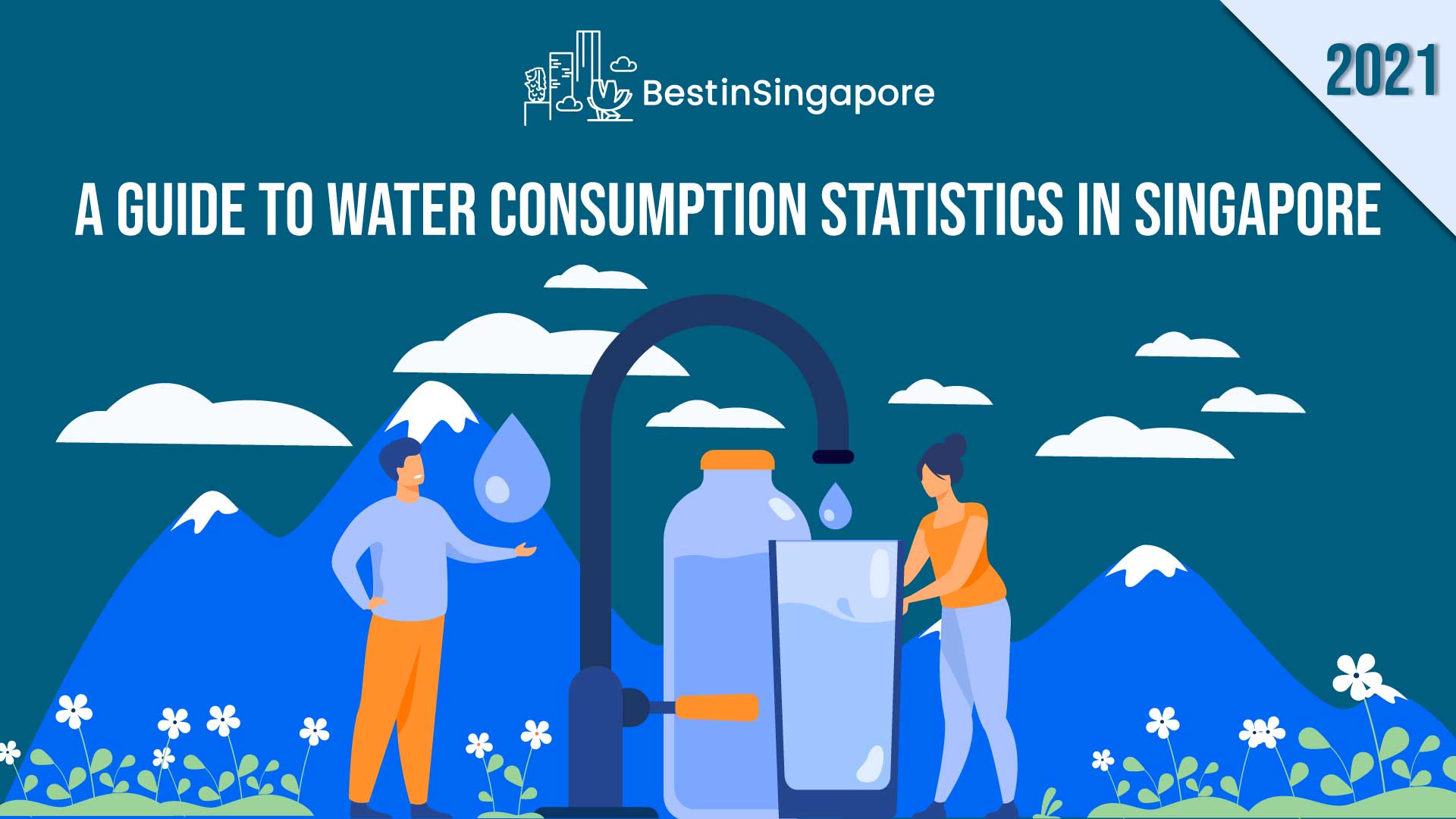A Guide to Water Consumption Statistics in Singapore – 2021
Key Insights
- Singapore uses about 663.6 million cubic meters (m3) of water each year. Per capita, this is equivalent to 116.7 m3, which places the island alongside countries like Israel (132.7 m3) and Slovakia (105.1 m3) in terms of water consumption.
- Using Luxembourg (86.4m3 ) as a reference, Singapore ranks fifth globally in terms of per capita water consumption.
- For total annual consumption, Singapore ranks slightly higher, coming in 54th out of 180 surveyed countries. As a reference, the highest annual usage was observed in the 180th country India, with a total of 761 billion m3.
- At current standards, the country’s daily water consumption amounts to 430 million gallons (gal) or 1.62 million m3.
- By 2060, Singapore’s water consumption is expected to double, reaching almost 1.32 billion m3 per year.
- From Singapore’s 4 national taps, the highest contribution comes from imported water at roughly 50%. Following this, NEWater is able to meet up to 40% of the country’s remaining demand.
- The lowest water contributions currently come from desalination plants and water catchments with maximum contributions of 30% and 10% respectively.
- Under its most recent water import agreement, Singapore is able to draw up to 250 million gal of water from the Johor River each day.
- Each year, Singapore’s NEWater plants produce around 285 million m3 of treated water. The largest portion of this total comes from the Changi Water Reclamation Plant with a contribution of 60%.
- The average Singaporean uses around 154 liters of water each day. Compared to the recorded consumption for 2019 the current level of consumption is up by 9.22%.
- 45% of the country’s daily consumption comes from the domestic sector alone. The remaining 55% is consumed by the non-domestic sector.
- In the average Singaporean household, the majority of water usage at 29% comes directly from shower usage. Following this is toilet usage and kitchen usage at 17% and 16% respectively.
- Recently, it was also found that households with domestic helpers generally consumed 20% more water as opposed to homes without domestic helpers.
- By 2030, Singapore hopes to lower its per capita water consumption to 130 liters per day. Along with this, desalinated water and NEWater are also expected to meet 80% of the country’s water demand in the same year.
Water is one of the most important natural resources that humans have access to. All living things require this clear tasteless substance in order to survive.
Unfortunately, due to a combination of climate change, overuse, and other factors, many parts of the world currently face serious water shortages. For the island city-state of Singapore, water or a lack thereof is slowly becoming a serious issue.
According to the World Resources Institute’s Water Stress Rankings, Singapore is tied with several other countries as the most water-stressed nation in the world. In this context, water stress is the relationship between water use and water availability.
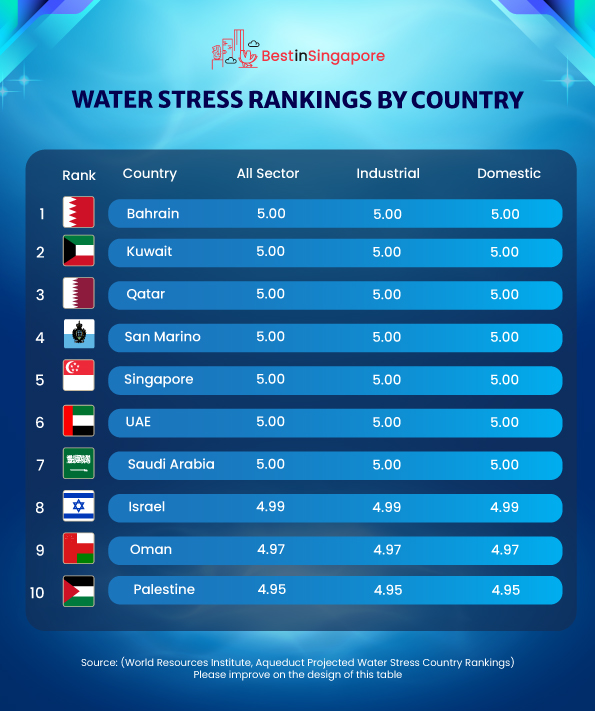
With a score of 5.00 out of 5.00, water stress is at the highest level in Singapore due to the lack of natural aquifers and heavy water consumption. To avoid severe water shortages, the island has developed various means of water production as well as sustainable consumption habits.
This article will examine the country’s current water consumption as well as the problems it faces along with its water sources and its future goals. To provide the utmost credibility, various statistics have also been gathered pertaining to the aforementioned topics.
From Water-Scarce to Water-Resilient
Within the span of a few decades, Singapore has gone from rationing its water to consuming roughly 663 million m3 each year. Per person, this figure translates to an annual consumption of 116.7 m3.
Using Luxembourg as a reference, Singapore ranks fifth among countries with the lowest per capita water usage. If one examines the country’s total annual consumption, this ranking jumps to 54 out of 180 for lowest water usage globally.
To put things into perspective, the annual per capita water consumption of the US is 1,206.8 m3, which is about 10 times that of Singapore. On the opposite end of the spectrum, Luxembourg’s per capita water consumption is 86.4 m3, which is 26% less than Singapore.
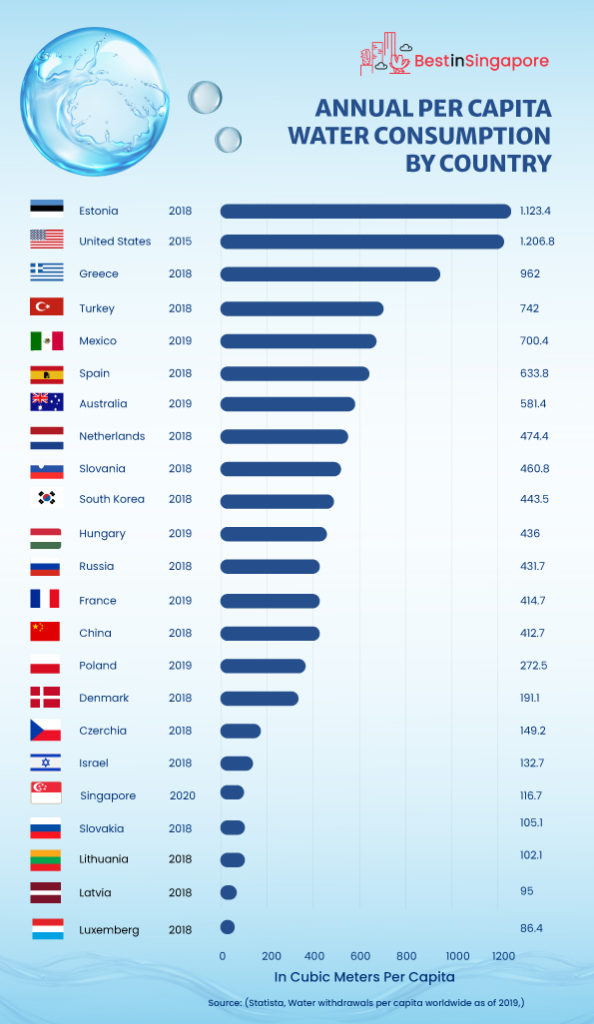
Based on the figure above, the Garden City sits between Slovakia and Israel in terms of annual per capita water consumption. On a daily basis, the country uses 430 million gal of water or 1.62 million m3.
Relative to some other countries, Singapore’s water usage is somewhat sustainable. But as one examines the nation’s annual water demand, the true problem begins to take shape.
The World’s Most Water-Stressed Country
As mentioned earlier, Singapore has the highest possible ranking on the water stress index. Despite its low water consumption and several water sources, the country’s ranking has remained the same for years.
This is largely due to the rising annual water demand from the country’s growing population. Since the 1960s, the country has seen a consistent upward trend between the population and water demand.
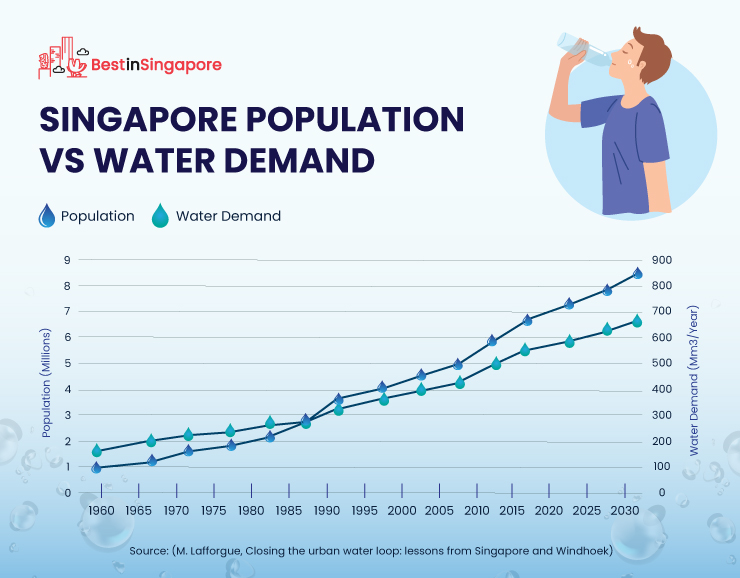
Given current conditions, experts project that Singapore’s water demand will reach 1.32 billion m3 per year by 2060. Realizing this, the country has focused on reducing overall water consumption and developing its water production capabilities.
Singapore’s water agency, the Public Utilities Board (PUB), is currently leading the overall development of the country’s water sources. In turn, this has led to notable improvements in water production as a whole.
Developing the Four National Taps
Singapore’s water sources are generally known as the Four National Taps. These consist of water from local catchments, imported water from Malaysia, recycled water known as NEWater, and desalinated water.
As an extremely small tropical country, Singapore sees heavy rain but lacks the geographical means to store it. This issue was solved with the creation of 17 reservoirs to help collect rainwater via rivers and used water via sewers.
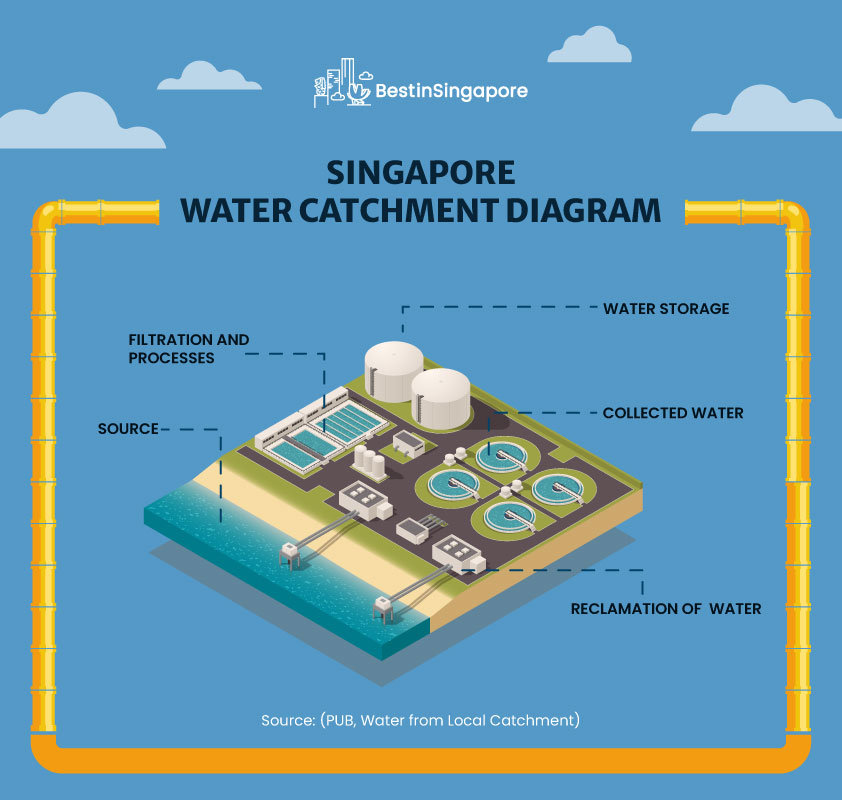
Overall, two-thirds (485 square kilometers (km2)) of the country’s land is devoted to collecting water. To visualize this, the figure below highlights the local catchment areas.

Among the 17 reservoirs in Singapore, the Marina Reservoir is the largest, with a total catchment area of 100 km2. Altogether, the catchments are able to provide roughly 10% of the island’s current water demand.
To ensure relatively high raw water quality throughout its system of reservoirs, the PUB tracks raw water through a combination of sampling and online sensors. In addition to this, regular water quality testing is also carried out.
Out of the Four National Taps, water from local catchments makes up the smallest contribution to the island’s water supply. Ironically enough, the largest contribution actually comes from outside of Singapore’s borders.
About 50 kilometers away from the heart of Singapore is the Johor River, one of 89 waterways on the Malaysian Peninsula. Following The 1962 Johor-Singapore Water Agreement, Singapore was allowed to draw up to 250 million gal of water each day from the Johor River.
The agreement currently provides the largest contribution to Singapore’s water supply at 50%. This remains the case even after 2% of the imported water is treated and returned to the neighboring country of Malaysia as per the water agreement.
Unfortunately, the import agreement is set to expire by 2061, which is when water demand is expected to double. Because of this, the country hopes to finish refining its other national taps by 2060.
One of the country’s most promising national taps is NEWater, a form of recycled water filtered through physical and chemical means. This occurs in three stages starting with filtration, then reverse osmosis, and finally, ultraviolet disinfection.

With five operational plants producing 172 million gal per day, NEWater is able to meet a whopping 40% of Singapore’s water demand.
Originally, water reclamation was thought to be far too expensive and costly to apply on a large scale.
This was the case until 1998, when the PUB commissioned a team to test the NEWater concept. After various improvements in filtration and water treatment, NEWater is now one of Singapore’s most reliable sources of water.

The final National Tap is desalination, which meets roughly 30% of the country’s annual water demand. Much like NEWater, this source of water is still quite costly given its unrefined processes.
Despite this, Singapore still runs three desalination plants producing 130 million gal per day. As technology improves, this process is also expected to become far more energy-efficient.

It is the PUB’s hope that once the Johor water agreement expires, desalinated water will have improved enough to make up for the loss of a significant water source. In an attempt to reduce water stress, the PUB has also started encouraging more conservative water consumption.
Singapore’s Water Consumption Habits
With over 1.3 million homes and two or more members to each household, it’s evident why Singapore’s domestic sector is responsible for 45% of the country’s entire water demand. Following this, the remaining 55% was used by various parts of Singapore’s industrial sector.

As an illustration, in 2019, the domestic sector used 297.6 million m3 of potable water. In turn, the industrial sector used 364.9 million m3 of water, with the majority also being potable.
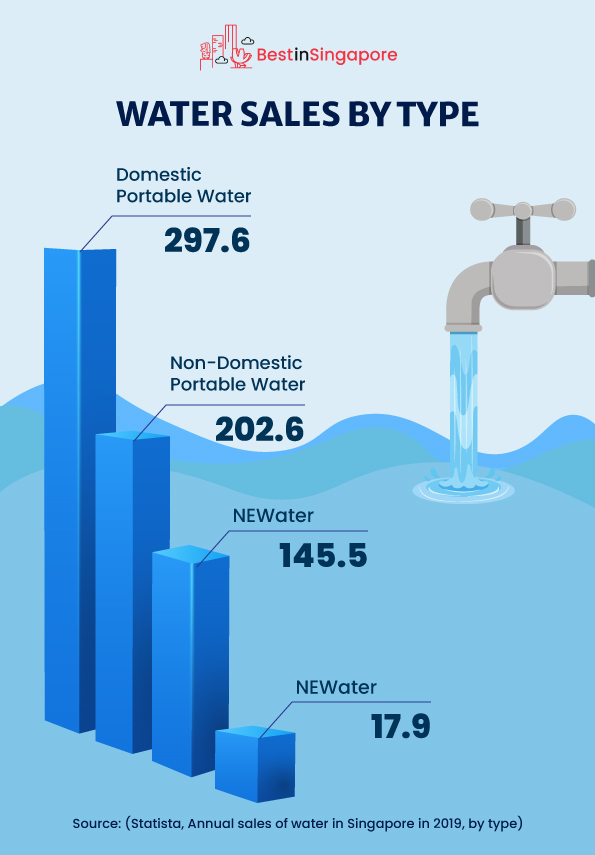
In 2020, the average Singaporean used approximately 154 liters of water over the course of a day. Compared to the value recorded in 2019 (141 liters per day), this represents a 9.21% increase in consumption.
The PUB attributes this substantial rise to the recent COVID-19 lockdowns, which forced many citizens to stay home. Overall, the level of consumption for 2020 is indicative of an all-time high not seen since 2010.

To pinpoint the highest sources of water consumption from the domestic sector, the PUB has conducted various household surveys. From these surveys, it was found that the majority of water in Singaporean households at 29% actually went towards shower usage.
Following this, the second and third-highest sources of water consumption were toilet usage and dishwashing at 17% and 16% respectively. Based on the figure below, these three sources have been the top forms of household water consumption since 2016.

Interestingly, the same survey also found that households with domestic helpers tend to consume more water. To be more specific, Singaporean households with domestic helpers used about 160 liters of water each day.
Alternatively, households without domestic workers only used an average of 135 liters of water per day. While this may seem insignificant, the 19% difference in daily water usage can translate to significant savings or losses over the course of a year.
The PUB attributes this increased water consumption to the higher level of activity often seen in homes with domestic helpers. Generally, homes with domestic helpers will end up washing more clothes, cleaning more, and also cooking more.
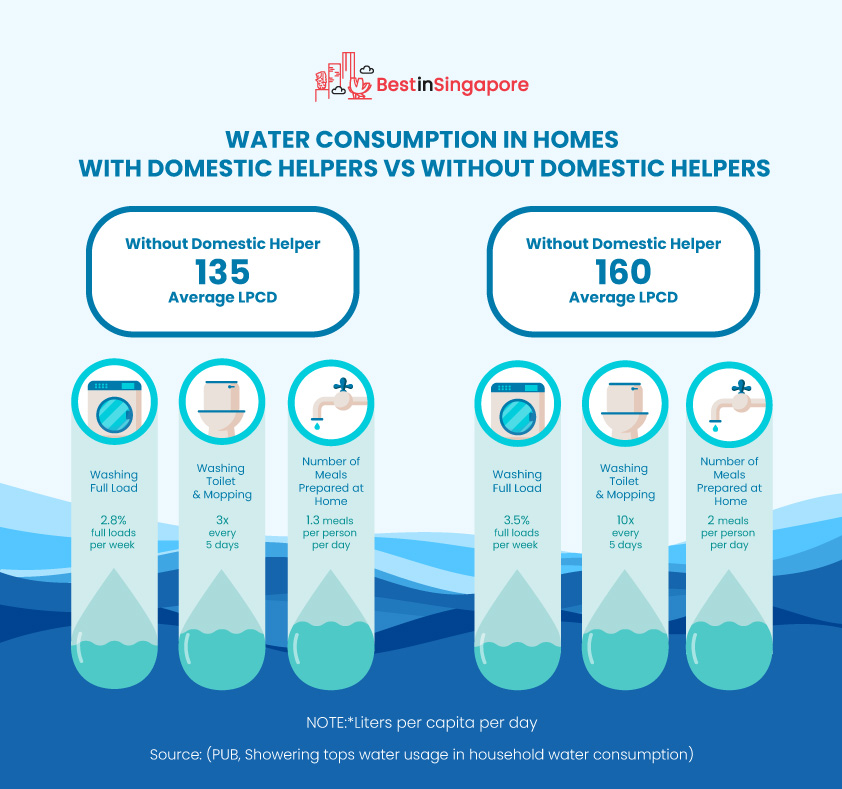
Overall, these statistics are indicative of wasteful water consumption habits and a lack of awareness with regard to saving water. As further proof of this, it was found that 94% of homes often wash their dishes under a running tap.
Additionally, 66% also use running water in order to clean toilets while 41.5% use running water to bathe their pets. Realizing the margin for improvement, the Foreign Domestic Worker Association for Social Support and Training (FAST) has begun to offer various workshops to address the issue.
These FAST programs help train domestic helpers to accomplish standard tasks without using as much water. If a large number of helpers take part in these programs, the PUB could see a serious reduction in water consumption from the domestic sector.
In turn, this will bring Singapore closer to its goal of reducing water stress levels through conservative practices and well-developed water sources.
Leaks and broken pipes are another contributing factor to increased water consumption in households.
Considering that most plumbing systems are located underground and out of sight, plumbing issues often go unnoticed until an upward trend in the water bills are noticed or until leaks manifest in visible spaces.
To counter this, the PUB recently launched the Smart Water Meter Programme, an accessible online portal that can provide SG citizens with data on their water consumption. One of the highlights of this service is the consumption alert system, which notifies the users of unusually high water usage or possible leaks in the system.
The PUB also recommends households and businesses to conduct regular checks for their plumbing systems at least once every two years.
And because of this, the demand for plumbing services stays fairly high on the island, with one of our most queried articles being our list of plumbing services in SG.
Working Towards Water Sustainability
With the Johor-Singapore water agreement set to expire by 2061, Singapore will lose its strongest national tap within 40 years. Knowing this, the PUB has set all its major infrastructure development goals for 2030 and 2060.
First and foremost, by 2030, the PUB hopes to cut Singapore’s per capita water usage to 130 liters per day. Given that the per capita water usage in both 2018 and 2019 was 141 liters, many experts believe this goal is relatively attainable even with the recent spike in 2020.
In 2030, NEWater’s net contribution to Singapore’s water supply is expected to increase from 40% to 50%. By the time water imports cease in 2060, this contribution is expected to rise even further to 55%.
At the moment, the PUB has yet to show any intent to increase the overall contribution of desalination plants to Singapore’s water supply. Instead, it aims to reduce the energy cost of desalination in order to make the process more efficient.
Despite not adding to overall water production, the development of more efficient desalination plants will be extremely helpful to Singapore’s power grid. This is significant due to the fact that desalination is one of the country’s most energy-intensive manufacturing processes.
Energy costs aside, desalination and NEWater plants are expected to eliminate Singapore’s dependence on water imports by 2060. In the same year, these two processes are also projected to meet 80% of Singapore’s total water demand.
Having experienced the challenges posed by water shortages in the 1960s, Singapore has built a diverse and reliable water supply. To mitigate the overall stress placed on this infrastructure, the country has also launched various campaigns to encourage water conservation.
Though it is still in development, Singapore’s water production system can be an excellent model for other water-stressed countries. In the end, it may even pave the way for other countries to also become water-resilient.
Sources:
- Aqueduct Projected Water Stress Country Rankings. (2015, August 26). World Resources Institute. https://www.wri.org/data/aqueduct-projected-water-stress-country-rankings
- Chong, C. (2020, March 10). Households with maids use 20 percent more water: PUB survey. The Straits Times. https://www.straitstimes.com/singapore/households-with-maids-use-20-per-cent-more-water-pub-survey
- Dhalla, A. (2017). Developing a Global Hydrohub. Chemistry and Water, 541-552. doi:10.1016/b978-0-12-809330-6.00016-7
- Lafforgue, Michel & Lenouvel, V.. (2015). Closing the urban water loop: Lessons from Singapore and Windhoek. Environ. Sci.: Water Res. Technol.. 1. 622-631. 10.1039/C5EW00056D.
- Meah, N. (2020, March 10). Many households still not adopting good water practices for toilet washing, food preparation: PUB. TODAYonline. https://www.todayonline.com/singapore/many-households-still-not-adopting-good-water-practices-toilet-washing-food-preparation
- Strengthening Water Resilience through Diversified Sources and. (2018, May 11). Development Asia. https://development.asia/case-study/strengthening-water-resilience-through-diversified-sources-and-conservation
- Tan, A. (2021, March 8). Budget debate: Per capita daily use of water shot up in 2020 as more people stayed at home. The Straits Times. https://www.straitstimes.com/singapore/budget-debate-as-more-people-stayed-at-home-per-capita-daily-use-of-water-shot-up-in-2020
- Water Agreements. (2021). Ministry of Foreign Affairs Singapore. https://www.mfa.gov.sg/SINGAPORES-FOREIGN-POLICY/Key-Issues/Water-Agreements#:%7E:text=Do%20we%20still%20import%20water,the%20water%20supplied%20to%20Singapore.

